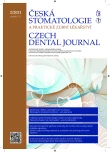ODONTOGENIC KERATOCYSTS TREATMENT – OUR EXPERIENCE
Authors:
J. Fabián 1; J. Pazdera 1; Z. Kolář 2
Authors‘ workplace:
Klinika ústní, čelistní a obličejové chirurgie, Lékařská fakulta Univerzity Palackého a Fakultní nemocnice, Olomouc
1; Ústav klinické a molekulární patologie, Lékařská fakulta Univerzity Palackého a Fakultní nemocnice, Olomouc
2
Published in:
Česká stomatologie / Praktické zubní lékařství, ročník 121, 2021, 2, s. 35-40
Category:
Original Article – Retrospective Essay
doi:
https://doi.org/10.51479/cspzl.2021.005
Overview
Introduction: Odontogenic keratocystics are benign intraosseous lesions. They are characterised by an local aggresive behaviour. Expansion is in anterior-posterior direction. This lesions were hidden for a long time. Orthopantomogram is gold standard examination, so nowadays diagnostics is not so difficult. But still there is relatively high recurrence rate and the choice of operation method is not definite. In this retrospective study is presented treatment modalities and succes rate.
Methods: In this retrospective study 62 patients are presented. This lesions were treated from 2000 to 2019 on Department of Oral and Maxillofacial Surgery in Faculty Hospital Olomouc. In this period 77 new and recurrence lesions of OKC were reported. This lesions were treated in local and general anaesthesia. OKC lesions are divided in several modalities: unilocular and multilocular and syndromic cysts. In this study, eight patients were treated with Gorlin-Goltz´s syndrome. Mutation of gen PTCH has been confirmed.
Result: Altogether 98 operations were carried out during nine years. Together 62 patients were treated. In local anaesthesia were treated 16 cases, in general anaesthesia 82 cases. The number of male and female was approximately same. Majority of cystic lesions
(57 cases = 74%) occured in lower jaw. Localization in lower jaw was majority in angle and branch of mandible.
(52 cases = 68%). More frequency on the right. five cysts (6%) were occured in frontal part of lower jaw. In maxilla, there were 20 cases (26%) of odontogenic keratocysts. Most number of OKC were diagnosed in second and sixth aged decade. Solitary OKC occured in 50 patients; eight patients with multiple OKC were genetic treated with confirmed Gorlin-Goltz syndrome. In one patient, seven years after first operation of OKC was malignancy on odontogenic carcinoma, 22 patients (35.5%) were reoperated for after surgery relaps. In relation between localization, postoperated relaps, authors compare succes of various operating methods (marsupialization, enucleation, enucleation with Carnoy´s solution, enucleation with augmentative methods, resection with and without free flap).
Conclusion: The choice of the treatment has always been difficult. And correct treatment modality is not complete. Patients should know various operation modalities, risk of reccurence and recommendation for long term dispenzarization.
Keywords:
odontogenic keratocyst – Cystectomy – Carnoy´s solution – marsupialization
Sources
- Pazdera J, Zbořil V, Geierová M, Kolář Z, Novotný J, Tvrdý P. K problematice odontogenních keratocyst. Čes Stomat. 2004; 104 : 171–179.
- Pazdera J, Kolář Z, Zbořil V, Tvrdý P,Pink R. Odontogenic keratocysts / Keratocystic odontogenic tumours: Biological charakteristic, clinical manifestation and treatment. Bio Med Pap. 2014; 158(2): 170–174.
- Gao L, Wang XL, Li SM, Ren WH, Zhi KQ. Decompression as treatment for odontogenic cystic lesions of the jaw. J Oral Maxillofac Surg. 2014; 72(2): 327–333.
- Cassoni A, Valentini V, Della Monaca M, Pompa G, Ianetti. G. Keratocystic odontogenic tumor surgical management: Retrospective analysis on 77 patients. Eur J Inflammation. 2014; 01 : 209–215.
- Wushou A, Zhao YJ, Shao ZM. Marsupialization is the optimal treatment approach for keratocystic odontogenic tumour. J Cranio-Maxillofac Surg. 2016; 42(7): 1540–1544.
- Moubayed SP, Khorsandi A, Urken ML. Radiological challenges in distinguishing keratocystic odontogenic tumor from ameloblastoma: An extraordinary occurence in the same patient, Am J Otolaryngol – Head Neck Med Surg. 2016; 37(4): 362–364.
- Pazdera J, Zbořil V, Tvrdý P, Kolář Z, Geierová M, Novotný J. Rekonstrukce kostních defektů po operacích objemných čelistních cyst. Čes Stomat. 2005; 105(3): 82–87.
- Blanas N, Freund B, Schwartz M, Furst IM. Systematic review of the treatment and prognosis of the odontogenic kertocyst. Oral Surg Oral Med Oral Pathol Oral Radiol Endod. 2000; 90(5): 553–558.
- Zhang Q, Li. W, Han F, Huang X, Yang X. Recurrent keratocystic odontogenic tumor after effective decompression. J Craniofac Surg. 2016; 27(5): 490–491.
- Sailer H, Pajarola G. Oral surgery for the general dentist. Stuttgart – New York: G. Thieme, 1999, 187–192.
- Leung YY, Lau SL, Troi KYY, Ma HL, Ng CL. Results of the treatment of keratocystic odontogenic tumours using enucleation and treatment of the residual bony defect with Carnoy´s solution. Inter J Oral Maxillofac Surg. 2016; 45(9): 1154–1158.
- Güler N, Sencift K, Demirkol O. Conservative management of keratocystic odontogenic tumour of jaws. Sci World J. 2012; 2012 : 680397.
- Ecker J, Horst RT, Koslovsky D. Current role of Carnoy´s solution in treating keratocystic odontogenic tumours. J Oral Maxillofac Surg. 2016; 74(2): 278–282.
- Pogrel MA. Keratocystic odontogenic tumour (KCOT) – An odyssey. Inter J Oral Maxillofac Surg. 2015; 44(12): 1565–1568.
- De Molon RS, Verzola MH, Pires LC, Cirelli A, Barbeiro RH. Five years follow-up of a keratocyst odontogenic tumor treated by marsupialization and enucleation: A case report and literature review. Contemporary Clin Dent, 2015; 6(5): 106–110.
- Dashow JE, McHugh JB, Braun TM, Helman JI, Ward BB. Significantly decreased recurrence rates in keratocystic odontogenic tumor with simple enucleation and curettage using Carnoy´s versus modified carnoy´s solution. J Oral Maxillofac Surg. 2015; 73(11): 2132–2135.
Labels
Maxillofacial surgery Orthodontics Dental medicineArticle was published in
Czech Dental Journal

2021 Issue 2
Most read in this issue
- SUMMARY OF KNOWLEDGE ABOUT 3D PRINTING AND ITS USE IN DENTISTRY
- BIOCERAMIC-BASED ROOT CANAL SEALERS – USE IN ENDODONTICS
- DENTAL COMPOSITE FILLING MATERIALS AS A POTENTIAL RISK OF TOXICITY FOR HUMAN ORGANISM
- ODONTOGENIC KERATOCYSTS TREATMENT – OUR EXPERIENCE
